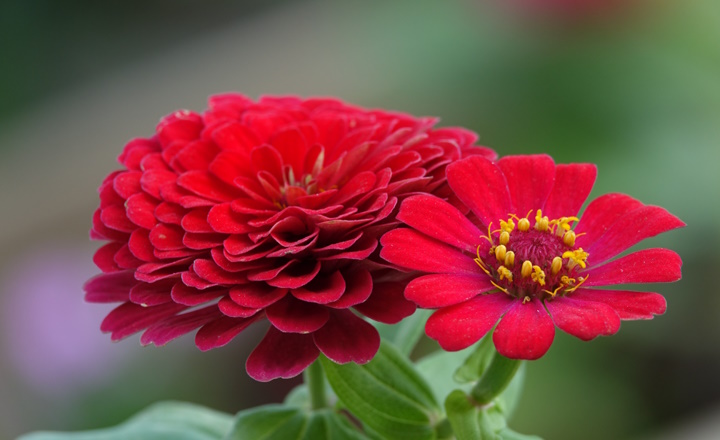 Image by lachetas on Freepik
Image by lachetas on FreepikYou can make your garden look better with zinnias, which are easy to grow and have bright flowers that last a long time. Gardeners of all skill levels love these happy annuals because they come in a lot of different colors, do well in warm climates, and are great at attracting pollinators like bees and butterflies.
From summer until the first frost, zinnias make a beautiful show whether you plant them in beds, borders, containers, or cutting gardens. We'll talk about everything you need to know to grow zinnias successfully, such as how to choose the right variety, get the soil ready, plant and care for your plants, and fix common problems.
Zinnias: Why Pick Them?
Zinnias are from Mexico and Central America. They are in the same family as daisies, which are called Asteraceae. Because they don't need much care and bloom a lot, they are a favorite among Australian gardeners, especially in warmer areas.
This is why zinnias are a great flower choice:
Growing quickly:
If you plant zinnias, they will bloom in just 6–8 weeks.
Blooms all the time:
They flower all summer with little work.
Different sizes and colors:
There are zinnias in every color.They come in orange, pink, lime green, and deep purple.
The best for cut flowers:
They are great for flower arrangements because their stems are strong and last a long time in a vase.
Get pollinators to visit:
Birds, bees, and even butterflies enjoy them a lot.
Picking the Right Kind of Zinnia
Zinnias come in a lot of different types, with over one hundred cultivars to pick from.When choosing a variety, think about the style of your garden, the plant's height, the shape of the flowers, and how you want to use it (borders, containers, cuttings, etc·).
Some popular types are:
The elegans zinnia:
With big, colorful blooms, this is the most common type for gardens.Different types range from dwarf (less than 30 cm) to tall (up to 1 m).
That's Zinnia angustifolia:
It's also known as creeping zinnia, and its narrow leaves make it great for borders and pots.
For Zinnia haageana:
It has smaller blooms that look like daisies and does best in hot, dry conditions. It is also called Mexican zinnia.
The best plants to try are:
It has tall stems with big, double flowers that are great for cutting.
The "Profusion" series is small, disease-resistant, and great for borders.
The "Zahara" series can handle both heat and drought and is great for pots.
Zoysias: Where and When to Plant Them in Australia
Zinnias like full sun, so put them somewhere that gets at least 6–8 hours of sun a day. Plant them in the spring, after the risk of frost has passed, because they like warm soil.
Weather guide:
Southern Australia, like Melbourne and Adelaide:
Plant in early to mid-spring.
In northern and western Australia, like in Perth and Brisbane,
Plant in late winter or early spring.
Tropical places:
Zinnias can grow almost all year, but they should be kept out of the rainiest months to avoid mildew.
How to Plant Rose Hips
You can plant zinnias directly in the ground or start them indoors and move them outside later.
For ease of use, direct sowing is recommended:
Loosen the soil until it's about 20 cm deep and get rid of any weeds.
Add compost or a balanced slow-release fertilizer to make the soil better.Depending on the type, plant the seeds 20 to 30 cm apart and about 1 cm deep.Cover lightly with soil and water slowly.
It usually takes 5–10 days for seeds to germinate.
Beginning inside:
Use seed trays and a light soil mix.
Plant seedlings when they have at least two sets of true leaves, which should be in three to four weeks.
Put plants outside for a few hours every day for a week to harden off before moving them.
Taking Care of Zinnias
Zinnias don't need much care, but they do like some attention to keep blooming at their best.
What to do:
To help strong roots grow, water deeply at the base.
Powdery mildew can be avoided by not watering from above.
Once they are established, zinnias can handle some drought.
Being fed:
Every 4–6 weeks, a light spray of balanced fertilizer or seaweed solution will keep the flowers blooming·
Don't give your plants too much nitrogen; it can make them grow leaves instead of flowers.
For deadheading:
Getting rid of old flowers on a regular basis will help new ones grow and extend the flowering season.
You can also pinch out the growing tips of tall varieties early to make the plants grow bushier.
How to Use Zinnias as Cut Flowers
Zinnias are one of the best cut flowers thanks to their vibrant colours, long-lasting blooms, and sturdy stems.
Tips on how to cut zinnias:
Cut the flowers first thing in the morning, when they are still very wet.
While zinnias are still open, pick blooms that are fully open.
Put in a clean vase with clean water, and take off the leaves that are below the water line. For best vase life (often up to 10 days!), change the water every day.
Using Zinnias in Funeral Plans
While zinnias are best known for their bright, cheerful colours and summer garden displays, they also hold a place in sympathy and funeral arrangements. In Victorian flower language, zinnias stood for remembering, long-lasting love, and thinking about a friend who has died every day. This makes them a meaningful addition to floral tributes. Their bright colors can be a gentle reminder of a life well lived, and their toughness can stand for love that lasts and strength. As a touching way to remember someone, zinnias are often combined with softer flowers like roses or chrysanthemums in casket sprays, wreaths, and memorial bouquets.
Trouble and Pests
Zinnias are usually very hardy, but they can have some problems, especially when it's humid outside.
Most common issues:
Mildew powder:
A sand-like white covering on the leaves.Increase air flow, don't water from above, and keep plants far apart.You should choose resistant types like Profusion·
Spider mites and caterpillars:
Use eco-friendly neem oil to spray or remove by hand.
Spots on leaves or botrytis:
Because of too much moisture.Cut off the weak leaves and make sure there is good drainage.
Extra Tips Planting with companions:
Zinnias are great plants to grow next to tomatoes, basil, and pumpkins because they keep pests away and attract pollinators.
Keep the seeds:
Let some flowers go to seed, then dry them out and put them in paper bags to save for next year.
Bring in variety:
To make your garden beds look like a painting, mix zinnia colors and types.
Why people who garden love zinnias
Zinneas are a great choice for both new and experienced gardeners. They do well in any Australian garden because they are easy to grow, flower for a long time, and have bright colors.
Zinnias are versatile and add a splash of color to any project, whether it's a cottage garden, a neat container arrangement on your patio, or a cutting garden.
A bed of zinnias dancing in the wind is one of the most relaxing sights to see at the end of a hot summer day. They are a living reminder that beauty doesn't have to be hard to achieve.
| < Prev | Next > |
|---|




